Dental Bone Graft Types
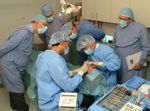
There are many ways in which a dental bone graft can be performed. It can be as simple as collecting bone from the patient, then reusing the bone for grafting purposes. Whenever a patient's own bone is used, the best results are usually achieved. In extreme cases, bone can be harvested from areas outside the mouth. The most common area is the hip. While most dentist believe the best material for a dental bone graft is your own bone, your dentist can use materials made from the bone of human cadavers or some other type of synthetic materials.
Bone Graft Types
Most bone augmentation procedures involve the use of the following dental bone grafts: autogenous, allografts and xenografts. Unlike Allograft, Allografts and Xenografts both do not require a second surgical site and ample amounts of this type of bone can be easily obtained.
Autogenous Grafts
Generally considered the best material for dental bone grafts, autogenous bone is the process whereby bone taken from adjacent sites of the patient such as the chin, hip or other areas of the patient's body when the goal is a dental implant. Autogenous bone is the standard as it oftentimes has the most predictable results. It is considered the best type of dental bone grafting technique because the bone is live bone and contains active cellular elements that enhance bone growth, whereas other types of grafts are devoid of any active cellular material.
Allograft Grafts
Allografts is synthetic bone or bone derived from genetically unrelated members of the same species, such as cadaver bone. Cadaver bone such as freeze dried cortical bone has been specifically prepared and found to be very effective for dental bone graft procedures. Cadaver bones promote the patients own bone to grow into the repair site, while synthetic materials stimulate bone formation, using factors from the patient's own blood to accelerate and promote bone formation in the dental graft areas.
Xenograft Grafts
Xenografts involve the use of bone that is been taken from other species such as cow. These materials generally work by either Osteoconduction or Osteoinduction. Osteoconduction involves the formation of new bone from host cells along a framework of a compatible biological material. Osteoinduction involves the formation of new bone from the biomechanically differentiation of the host mesenchymal cells. Bone Morphogenic Protein (BMP) is the material that stimulates osteoinduction which is rapid growth of bone just about anywhere on the body.
While most dentists prefer to use a person's own bone, maybe in combination with other materials, the choice is yours. Discuss your options as well as the risks and benefits with your dentist before deciding to perform a dental bone graft procedure.
If you decide to have bone taken from your own body to use for bone grafting, it will most likely be taken from the chin or the back part of your lower jaw area. If your dentist cannot get enough bone from these areas, then the hip or shin bone area may be used instead. The hip is considered to be a better source because the hip area contains a lot of marrow that contains bone-forming cells.
Some people wanting implants may be missing several teeth and need several implants, as well as a dental bone graft. Because more bone graft is needed, the bone will probably need to be taken from the hip, shin or another site. Due to the amount of bone buildup needed in this case, this type of dental bone graft procedure is done in the hospital under general anesthesia, and usually requires an overnight stay at the hospital.
The rate of success for dental bone grafts as it relates to performing dental implant surgery is very high. However, there is always a chance that the dental bone graft will fail, even in cases where the person's own bone was used. The failure of a dental bone graft usually is because of an infection or because the grafted bone was unstable and loosened from the jaw. Dentists don't know with certainty why some bone grafts fail, but they do know that people who smoke and have certain medical conditions possess a higher risk of graft failure than others. If a dental bone graft fails, it is removed and a second graft can be placed once the area has had a chance to heal.
Other Types of Bone Grafts
In addition to bone grafting, there are many other types of procedures that can be used to build bone so that implants can be place:
The Sinus Lift - The sinus lift increases the height of your upper jaw by filling part of your upper sinus area with bone. This procedure is performed when there is not enough bone to allow implants to be placed in the back part of the upper jaw.
The Ridge Expansion - is performed when the jaw is not wide enough to support implants; the height and/or width of the ridge area is increased in order to accommodate a dental implant.
Distraction Osteogenesis- refers to the process of separating two pieces of bone in order to form of new bone.
The human skull has several cavities or air spaces which are called sinuses. Sinuses make the head lighter so that it can be supported on the neck. Sometimes, the sinus cavities are enlarged and intrude on dental implant site areas. To place a dental implant into the sinus would only result in placing it into an air cavity where nothing is holding it in place. So bone or bone growth stimulating material is introduced into the sinus.
A sinus lift procedure only affects the maxillary sinuses which are located just over the molar teeth in the upper jaw. There are no sinuses in the lower jaw. To introduce bone into the maxillary sinus, the side of the sinus is opened and the bottom portion of the sinus is raised in order to fill in with bone. After several months, dental implants can be placed into in solid bone. Sometimes, after raising the sinus, dentists may find that there is enough bone to place the implants and can proceed with the dental implant much sooner.
There is also a more conservative way to grow bone in the sinus. An "Osteotome Lift" raises the floor of the sinus right over the area of the implant site. This dental graft procedure can be done without actually opening the sinus. The healing and implant integration process will proceed as normal. Sinus lifts of all types have had high success rates and are commonly used to effectively promote dental implant procedures.
Sinus Lift Illustration
 |
 |
 |
Stage 1 Area |
Stage 2 Area |
Stage 3 Area |
This procedure involves elevating the sinus membrane and placing the bone graft onto the sinus floor (Stage 2 Area). This allows implants to be placed in the back part of the upper jaw when teeth have been removed and bone loss has occurred. The implants can often be placed at the time the grafting is performed (Stage 3 Area)
Ridge Expansion
Another type of bone augmentation procedure is called a ridge expansion. In severe cases the ridge has been reabsorbed and a bone graft is placed to increase the ridge height and/or width. In these situations, the graft is taken from another area inside your mouth. This procedure can be performed in a doctor's office under local anesthesia and takes about an hour. A ridge expansion is a type of bone graft procedure that is performed when the jaw is not wide enough to support implants. A special saw is used to split the jaw along the top, then dental graft material is packed into the newly created space (Step 5). Some dentists will immediately place implants after this procedure is done (Step 6), while other dentists' will wait several months for the ridge to heal.
Ridge Expansion Illustration
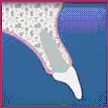 |
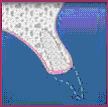 |
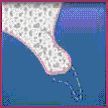 |
Step 1 |
Step 2 |
Step 3 |
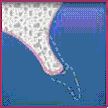 |
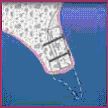 |
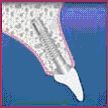 |
Step 4 |
Step 5 |
Step 6 |
Distraction Osteogenesis
One of the newest procedures of bone augmentation is called distraction osteogenesis. The term distraction refers to the process of separating two pieces of bone, while the term osteogenesis refers to the forming of new bone.
Originally used for lengthening the bones of patients with abnormally short legs, distraction osteogenesis has been adapted for regeneration of lost bone structures of the face and mouth. The procedure involves a surgeon cutting the jawbone to separate a piece of bone from the rest of the jaw. A titanium device is inserted into the jaw with pins or screws holds the piece of bone apart from the rest of the jawbone Over time (usually over a period of days or weeks), the space between this piece of bone and the jawbone is widened slightly by unscrewing the device, while the area between the pieces gradually fills in with new bone.
Costs of Dental Bone Grafts
There are some potential downsides when dental bone grafting is needed for a dental implant. The process of the bone graft and the healing period may add a significant amount of time to the process. Another downside is the increasing costs associated with dental bone grafting and dental implant procedures. Some dentists attempt to keep the costs of dental implant procedures as low as possible, while other apply very high fees when dental bone grafting is involved. They tend to mystify these procedures and make them appear to be very costly.
According to one doctor, a bottle of Freeze Dried bone costs about $95.00, while membranes cost between $35.00 and $150.00. He uses a sliding scale for grafting charges from $250.00 to $750.00 based upon how much bone and other materials are used and the difficultly of the procedure. His fee for a sinus lift is $1250.00, well below that of other dental offices where charges can range from $2500.00 to $25,000.00 depending upon the type of grafts. He believes that some dentists use tactics to inflate the fees for dental bone graft procedures, and wants patients to be informed about the process.
He also discussed some dentists utilizing a technique which involves the use of a platelet centrifuge. The process involves withdrawing and placing a small amount of the patient's blood into the centrifuge, which then creates plasma that is rich in platelets. These platelets are then added to the bone graft in order to speed up the healing process. While, the use of a platelet centrifuge is useful in promoting bone graft development, the equipment can cost several thousands of dollars and the costs are passed on to the dental patient. He believes that some dentists tend to overuse the technique to pay for their investment. In one instance, a patient, who had more bone that he could possibly ever need, was given a platelet sediment treatment and charged an additional $2500.00!
So if you are looking to get a dental implant, research the process of bone grafting in the event that you will need to have this procedure performed prior to the implant placed. Then research those doctors who perform the procedure and do a shopping comparison. Knowing that there are disparities in the costs associated with a dental implant can save you hundreds, if not thousands of dollars for a dental implant procedure.
